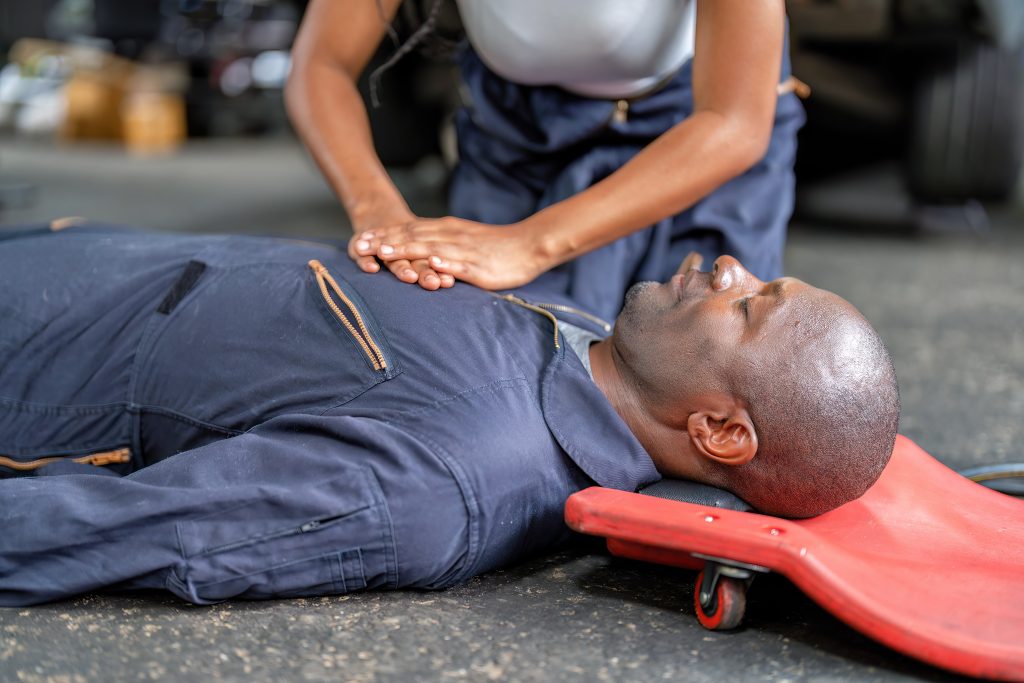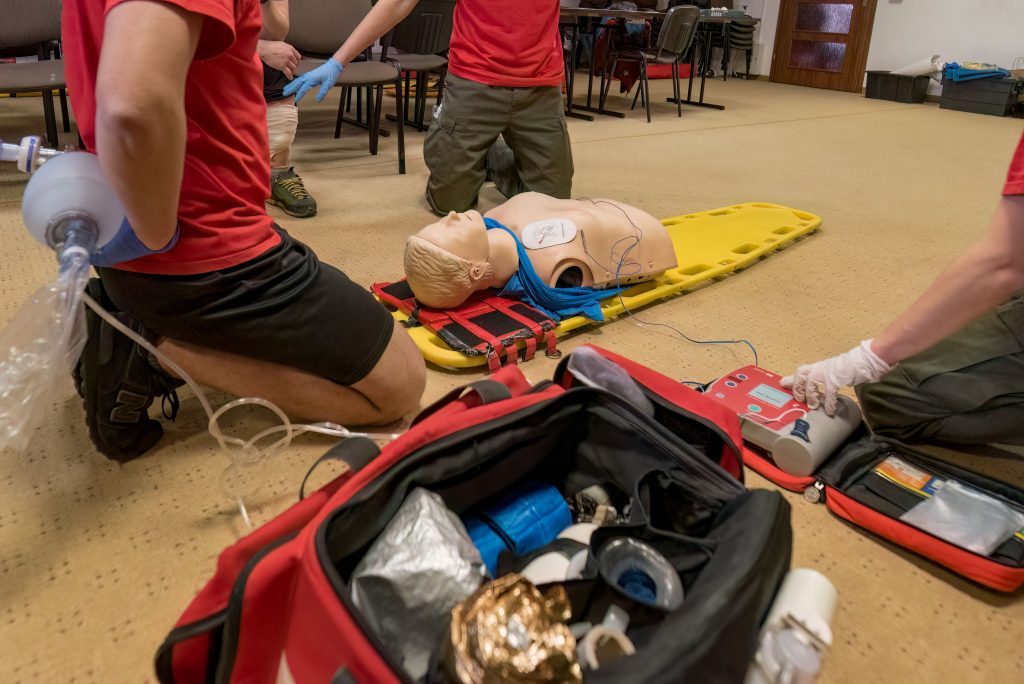OSHA First Aid: A Compliance Checklist for Raleigh Businesses

For every business operating within the vibrant, rapidly expanding economy of Raleigh, North Carolina, safety compliance is not merely a bureaucratic checkbox. It is a fundamental responsibility. Workplace injuries, while hopefully rare, demand an immediate and effective response. In these critical moments, having a robust, compliant first aid program is the difference between a minor incident and a tragic, preventable fatality.
The regulatory authority overseeing these requirements is the Occupational Safety and Health Administration (OSHA). OSHA’s standard 29 CFR 1910.151 sets the foundation for medical services and first aid across most general industries. This standard applies equally to a small tech office downtown or a large manufacturing facility on the outskirts of Wake County.
However, compliance with this specific standard is uniquely challenging because it is performance-based. It doesn’t hand out a single, universal checklist. Instead, it requires Raleigh businesses to assess their specific risks and proximity to emergency medical services (EMS). This guide translates the complex language of OSHA into a practical, actionable checklist designed specifically for employers in the Raleigh area. Our goal is to ensure your workplace is prepared, compliant, and, most importantly, safe, with the right training provided by certified experts like CPR Classes Near Me.
What is the Core OSHA Requirement for First Aid Personnel in Raleigh Workplaces?
OSHA’s fundamental requirement regarding first aid personnel revolves entirely around the question of prompt attention. Simply put, every employer must ensure that prompt medical attention is available to every injured employee.
The primary regulatory provision is found in 29 CFR 1910.151(b). This section states that in the absence of an infirmary, clinic, or hospital in near proximity to the workplace, which is used for the treatment of all injured employees, a person or persons must be adequately trained to render first aid. Adequate first aid supplies must also be readily available.
For many businesses in the Raleigh metropolitan area, especially those outside the downtown core or located in industrial parks, relying on a nearby hospital is not a fail-safe strategy. The key to compliance is understanding how OSHA defines that crucial term, “near proximity.” This interpretation is what determines whether your company is required to invest in on-site first aid and CPR training.
If your workplace location cannot guarantee swift access to professional medical services, the burden falls on you, the employer, to designate and train employees to serve as immediate first responders. This trained personnel must be available on-site during all working hours, across all shifts. Their certification must be current, reflecting training from nationally recognized programs like those accredited by the American Heart Association (AHA).
Raleigh businesses must not only look at the distance to the nearest clinic but also the guaranteed response time of the local EMS system, a far more challenging metric to confirm. If your assessment shows a potential delay in external emergency care, then establishing an internal, certified first aid response team becomes a legal necessity, not just a safety recommendation.
This requirement also mandates consultation. Employers must ensure the ready availability of medical personnel for advice and consultation on matters of plant health (29 CFR 1910.151(a)). This means having a formal arrangement with a healthcare professional to assist in designing and reviewing your workplace’s safety and health program. Compliance is a continuous loop, requiring ongoing review and adaptation to changing workplace conditions.

How Far is “Near Proximity” According to OSHA’s 3-4 Minute Rule?
The term “near proximity” in OSHA standards is intentionally vague in the text but has been consistently clarified through interpretation letters and enforcement actions. These interpretations provide Raleigh businesses with a critical, time-based standard.
OSHA defines “near proximity” by response time, differentiating based on the likelihood of a catastrophic injury at your specific worksite. This distinction is paramount for determining your training obligations.
The Strict 3-4 Minute Rule (High-Hazard Workplaces):
For workplaces where there is a reasonable possibility of a serious, life-threatening injury, the emergency medical response time must be no more than 3 to 4 minutes.
- What constitutes a high-hazard workplace?
- Any site where injuries involving stopped breathing, cardiac arrest, profuse uncontrolled bleeding, falls, suffocation, electrocution, or amputation are possible.
- Examples include most construction sites, manufacturing operations, industrial facilities, and certain utility or maintenance jobs around Raleigh.
If your Raleigh business falls into this category, and the local EMS cannot guarantee a response within that 3–4 minute window, you must have on-site employees who are adequately trained and certified in first aid and CPR. This trained individual must be able to reach the victim within the 3–4 minute timeframe.
The Extended 15-Minute Rule (Low-Hazard Workplaces):
OSHA recognizes that a slightly longer response time is acceptable in environments where the possibility of a serious, life-threatening injury is more remote.
- What constitutes a low-hazard workplace?
- Typical office environments, retail stores (excluding kitchens or workshops), and administrative settings.
- In these cases, a response time of up to 15 minutes may be deemed reasonable by OSHA.
However, even in a low-hazard Raleigh office, relying on the 15-minute rule requires constant vigilance. If, for instance, a server room technician is working alone and is accidentally electrocuted, a high-hazard scenario, the 3–4 minute rule immediately applies. Because it is challenging to guarantee a 3–4 minute EMS response time anywhere, having trained personnel is almost always the safest and most legally defensible approach to compliance in the Raleigh area.
This dual interpretation means that Raleigh employers must perform a thorough worksite analysis to identify all potential high-hazard scenarios and set their first aid program’s standard accordingly. It is safer to train personnel than to gamble on the speed of the nearest emergency room.
How Can Raleigh Businesses Create an OSHA-Compliant First Aid Program?
Compliance with OSHA 1910.151 involves more than just purchasing a first aid kit; it requires a structured, four-part program that addresses management, analysis, control, and training. This framework is essential for achieving and maintaining safety compliance in any Raleigh-based operation.
The Raleigh Business Compliance Checklist:
- Management Leadership and Employee Involvement:
- Appoint a Program Administrator: Designate a specific individual to be responsible for all aspects of the program, including training, supply checks, and recordkeeping.
- Develop Written Policies: Document your company’s emergency action plan (EAP) and your specific first aid plan.
- Ensure Ready Consultation: Establish a formal relationship with a local medical professional for advice on occupational health matters and the content of your first aid program.
- Worksite Hazard Analysis:
- Conduct a Hazard Assessment: Walk through every area of the workplace to identify specific hazards—from machinery and chemicals to slip/fall risks.
- Determine Response Time: Verify the guaranteed response time of local EMS to your worksite and classify your facility as high- or low-hazard based on the 3–4 minute rule.
- Review Injury Logs: Use the OSHA 300 log and other injury reports to identify common or unique workplace injuries that require specialized supplies or training.
- Hazard Prevention and Control:
- Provide Corrosive Protection: If corrosive materials are used, ensure suitable facilities for quick drenching or flushing of the eyes and body are available within the immediate work area (29 CFR 1910.151(c)).
- Establish Communication: Ensure all employees know how to quickly report an emergency and communicate the location of first aid providers and supplies.
- Maintain Supplies: Assign a person to inspect and replenish all first aid supplies at sufficient intervals (at least monthly, and immediately after any use).
- Safety and Health Training (The First Responder Mandate):
- Designate Trained Personnel: Ensure that at least one employee, or more depending on the size and shifts, is adequately trained to render first aid and CPR.
- Use Recognized Training: Ensure training is comparable to that of the American Heart Association (AHA) or American Red Cross, emphasizing hands-on skills.
- Mandate CPR/AED: Given the life-critical nature of cardiac arrest, OSHA’s best practices guide strongly recommends that first aid providers also be certified in Cardiopulmonary Resuscitation (CPR) and know how to use an Automated External Defibrillator (AED).
What are the Mandatory Supplies and Equipment for OSHA First Aid Kits?
While OSHA requires that “adequate first aid supplies shall be readily available” (29 CFR 1910.151(b)), it does not provide a mandatory list for general industry. Instead, OSHA points employers toward the American National Standard (ANSI) Z308.1 as the minimum content requirement. Raleigh businesses should use the latest ANSI standard to ensure their kits are “adequate.”
OSHA mandates that supplies must:
- Be readily available and easily accessible to all employees.
- Be kept in a sanitary and usable condition.
- Be replenished as necessary after use or expiration.
The contents of the kit must be tailored to the specific hazards of the Raleigh workplace. For example, a landscaping company needs supplies for severe cuts and insect bites, while a lab needs supplies for chemical exposure.
ANSI Z308.1 Minimum Kit Requirements (The OSHA-Recommended Baseline):
OSHA encourages using ANSI standards to determine your kit contents, differentiating between two classes based on your workplace risk:
- Class A Kits (General/Low-Risk): Typically sufficient for offices and retail, these kits contain items like adhesive bandages, antiseptic wipes, a breathing barrier, one cold pack, a burn dressing, hand sanitizer, medical exam gloves, and trauma pads.
- Class B Kits (High-Risk/Complex): Recommended for manufacturing, construction, and high-hazard environments, these kits contain larger quantities of all Class A items and require specialized equipment for trauma. Key mandatory additions include:
- A Tourniquet.
- A Splint.
- Larger capacity Eye/Skin Wash.
- Increased quantities of adhesive tape and roller bandages.
Key Considerations for Raleigh Employers:
- Corrosive Material Facilities: If your work involves injurious corrosive materials, you must provide quick-drenching and flushing facilities, like an eyewash station, for immediate emergency use within the work area. This is a separate, non-negotiable requirement (29 CFR 1910.151(c)).
- Bloodborne Pathogens: Employers whose first aid responders may be exposed to blood or other potentially infectious materials must provide appropriate personal protective equipment (PPE), such as gloves, gowns, and face shields, in compliance with the Bloodborne Pathogens Standard (29 CFR 1910.1030).

What Type of First Aid Training Meets OSHA Standards?
The entire OSHA first aid program hinges on the competence of your designated personnel. Training must not only cover basic skills but also instill the confidence and practical ability required to act effectively within the narrow, life-saving window of 3–4 minutes.
OSHA specifies that the training must be “adequate” and should be comparable to that of a national organization like the American Red Cross or the American Heart Association (AHA). The best-in-class programs universally share key characteristics that define OSHA compliance:
Characteristics of OSHA-Compliant First Aid and CPR Training:
- Nationally Recognized Certification: The certification card must be issued by a reputable, nationally recognized organization, such as the American Heart Association (AHA). The AHA’s Basic Life Support (BLS) certification, often combined with a comprehensive First Aid course, is the gold standard and is recognized across the nation. CPR Classes Near Me Raleigh offers this level of training.
- Hands-On Skill Practice (Mandatory): Online-only, didactic training is generally not accepted by OSHA as meeting the adequacy requirement. Effective first aid training is practical, requiring hands-on components where participants physically practice life-saving skills.
- Skills to Master: Chest compressions, rescue breathing, wound care, splinting, and use of an Automated External Defibrillator (AED).
- Site-Specific Focus: The training should be customized to address the most likely injuries at your Raleigh workplace. A construction crew needs more trauma training than a dentist’s office.
- Bloodborne Pathogens (BBP) Integration: Any employee who may be expected to render first aid as part of their duty must receive specific training on the BBP Standard (29 CFR 1910.1030). This includes how to use PPE and properly handle and dispose of contaminated materials.
- Refresher and Recertification: Certifications, including AHA BLS and First Aid, are typically valid for two years. Employers are responsible for ensuring that all designated first responders maintain current credentials. Scheduling regular refresher training is vital to prevent skills from degrading.
Why Choose AHA-Aligned Training in Raleigh?
When selecting a training partner, Raleigh businesses should prioritize those who offer the most employer-accepted credentials. CPR Classes Near Me Raleigh provides the American Heart Association (AHA) certified training, which is specifically highlighted by OSHA’s own literature as meeting the standard’s requirements.
- AHA BLS CPR & First Aid: This combined course teaches comprehensive skills for sudden cardiac arrest, choking, wounds, burns, and environmental emergencies, all the scenarios required for a robust first aid program.
- Same-Day eCards: Efficiency is key. Reputable local providers can issue same-day certification eCards, ensuring your employees are officially compliant immediately upon successful completion of the course.
By utilizing a certified local provider like CPR Classes Near Me, Raleigh employers can confidently check the “Adequately Trained” box on their OSHA compliance checklist, knowing they have met the most rigorous national standard.
Conclusion: Securing Your Raleigh Business Through Proactive Readiness
OSHA workplace first aid requirements are not abstract rules written for faraway industries; they are specific, time-sensitive mandates that directly apply to every Raleigh business. Compliance boils down to one simple question: Can you ensure prompt medical attention for an injured employee within the critical 3–4 minute window?
For most businesses, the only dependable answer is “Yes, because we have trained personnel.”
By conducting a thorough hazard analysis, implementing the necessary ANSI-compliant supplies, and most importantly, investing in hands-on, nationally certified first aid and CPR training, you move beyond mere compliance. You create a culture of readiness that protects your most valuable asset: your employees. Being prepared safeguards lives, reduces liability, and ensures your operation continues smoothly, even when the unexpected occurs.
Don’t wait until an emergency arises to discover your first aid program is inadequate. Start your compliance journey today by ensuring your team receives the best, most recognized training available.
Take the next step toward guaranteed OSHA compliance.
Ready to ensure your Raleigh business is fully compliant with OSHA’s life-saving first aid requirements? Contact CPR Classes Near Me today to schedule American Heart Association (AHA) certified BLS CPR and First Aid training for your entire team. We offer group and on-site courses tailored to your specific workplace hazards.
Contact CPR Classes Near Me to schedule your group certification!
OSHA First Aid: Frequently Asked Questions
Does OSHA require every employee in a Raleigh office to be CPR certified?
No, OSHA does not require every employee in a Raleigh office or low-hazard workplace to be CPR certified. The requirement, under 29 CFR 1910.151(b), is only that a person or persons be adequately trained to render first aid when a hospital or clinic is not in “near proximity.” For low-hazard workplaces, “near proximity” is generally interpreted to mean emergency services can arrive within 15 minutes. However, OSHA recommends training for more people than just the designated responders. For high-hazard environments, the 3–4 minute rule often makes having multiple trained responders mandatory for compliance, and since cardiac arrest can happen anywhere, CPR certification is a critical component of that training.
How often must our employees renew their First Aid and CPR certifications to remain OSHA compliant?
First Aid and CPR certifications must be renewed periodically to maintain compliance, as determined by the certifying organization. Certifications from recognized organizations like the American Heart Association (AHA) or American Red Cross are typically valid for two years. The employer is responsible for tracking these expiration dates and ensuring that designated first responders complete a refresher course and renew their certification before it expires. OSHA emphasizes that training should be repeated periodically to maintain and update knowledge and skills, recommending instructor-led retraining at least annually for life-threatening emergencies.
Are we required to have an Automated External Defibrillator (AED) on-site in our Raleigh business?
OSHA does not have a federal standard that specifically mandates the placement of an AED in every workplace. However, the use of an AED is an integral part of modern life-saving practices, and OSHA’s Best Practices Guide strongly recommends that first aid programs include AED usage training and equipment, especially in environments where electrocution or cardiac arrest is a known risk. Furthermore, AED placement and usage are often governed by specific North Carolina state laws, which may offer legal protections (Good Samaritan laws) to those who respond to cardiac emergencies using an AED. For maximum safety and liability protection, providing an AED and training employees through programs like those offered by CPR Classes Near Me is highly encouraged.
What is the difference between an ANSI Class A and Class B first aid kit, and which one does my Raleigh business need?
The American National Standard Institute (ANSI) Z308.1 defines two classes of kits, which OSHA references for minimum supply recommendations: Class A Kits are designed for low-hazard work environments, containing the minimum basic supplies to treat common injuries. Class B Kits are designed for high-risk work environments, containing a wider variety and larger quantity of supplies, including mandatory items for severe trauma like a tourniquet and splints. Your Raleigh business should conduct a hazard assessment to determine which class is appropriate. If your risk assessment shows potential for severe injuries (e.g., crush injuries, severe bleeding), a Class B kit is required to meet OSHA’s “adequate supplies” standard.
Does our company need to provide Bloodborne Pathogens (BBP) training for our first aid responders?
Yes, absolutely. If your Raleigh company designates employees as first aid providers, and there is a “reasonable anticipation” that they will have skin, eye, mucous membrane, or parenteral contact with blood or other potentially infectious materials (OPIM) while performing their first aid duties, they must receive training that complies with the OSHA Bloodborne Pathogens Standard (29 CFR 1910.1030). This BBP training must cover the use of personal protective equipment (PPE), exposure control plans, Hepatitis B vaccination, and post-exposure evaluation and follow-up. First aid providers trained by CPR Classes Near Me often receive this critical BBP awareness training as part of their comprehensive certification.
